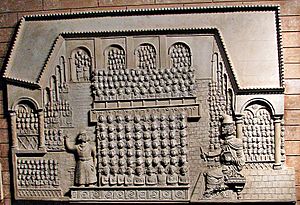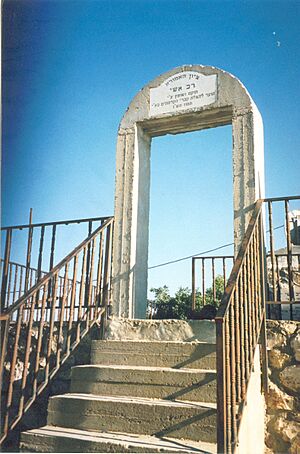Rav Ashi facts for kids
Rav Ashi (born 352 CE, died 427 CE) was a very important Jewish leader and scholar from Babylonia (which is now Iraq). He was part of a group of wise teachers called the Amoraim, who lived after the Mishnah was written. Rav Ashi is famous for bringing the Sura Academy back to life. He also started the huge job of putting together the Babylonian Talmud, which is a collection of Jewish laws and stories.
Contents
Rav Ashi's Life Story
Rav Ashi was born in the same year that another great teacher, Rava, passed away. This made him the next big leader in Jewish learning in Babylonia. His father, Simai, was a wealthy and smart man who studied at a college near Sura.
Rav Ashi himself was taught by Rav Kahana III. Later, Rav Kahana became the head of another important school in a city called Pumbedita. Rav Ashi was also a very rich and powerful person. He owned a lot of land and forests. People said he was special because he had both great knowledge of the Torah and strong leadership skills. He was even respected by the Exilarch, who was the leader of the Jewish community at the time.
Sura Academy Becomes Important Again
Even when he was young, Rav Ashi became the head of the Sura Academy. Everyone recognized how incredibly smart he was. This academy had been closed for a long time, but Rav Ashi made it the most important place for Jewish learning in Babylonia once more.
He also made the academy building very grand. He rebuilt the school and the synagogue next to it, spending a lot of money and making sure everything was perfect. Because Rav Ashi was so famous, the Exilarch would visit Sura every year after the Jewish New Year (Rosh Hashana). People from all the Babylonian academies would gather to show their respect. These events were so impressive that Rav Ashi was surprised some non-Jewish people in Sura weren't inspired to become Jewish!
Sura stayed a very important center of learning for many centuries because of Rav Ashi. His son, Tabyomi, was also a respected scholar. However, it took 28 years after Rav Ashi's death for his son to become the head of the Sura Academy, a position his father had held for over 50 years.
Putting Together the Gemara
People often compared Rav Ashi to Rabbi Judah ha-Nasi, who put together the Mishnah. This is because Rav Ashi took on the huge task of collecting and editing all the explanations of the Mishnah. These explanations were called the Gemara. They included all the discussions, laws (halakha), and stories (aggadah) that had been taught in the Babylonian schools since the time of Rav.
Rav Ashi worked on this project with his students and other scholars who came to Sura for special conferences called "Kallah." The king, Yazdegerd I, was kind to the Jews, and the other academies also respected Rav Ashi's authority. This helped his big project succeed.
Rav Ashi was the head of the Sura Academy for a very long time, possibly 60 years. It is said that he spent 30 years studying and editing each part of the Talmud, and then repeated the whole process for another 30 years. This shows how much effort he put into this massive work.
We don't know for sure if Rav Ashi wrote down the entire Babylonian Talmud himself. However, it's likely that such a huge work needed to be written down to be completed. The work that Rav Ashi started was continued by scholars in the next two generations and finished by Ravina II. After Ravina, only small additions were made. Rav Ashi and Ravina are seen as the last great leaders who made independent decisions about Jewish law. Their work on the Babylonian Talmud became as important for future generations as the Mishnah was for their own time.
Rav Ashi's Teachings
- A wise student who isn't as strong as iron is not truly wise.
- Anyone who is too proud has a flaw.
Rav Ashi's Tomb
Many Jewish people believe that Rav Ashi's tomb is on a hill near a place called Manara in Israel. However, some Muslims believe it is the tomb of Sheikh Abbad, a Shi'ite Muslim leader who lived about 500 years ago.
When Israel left South Lebanon in 2000, deciding who owned this tomb was one of the last things to be settled for the United Nations peacekeepers to be placed along the border. One idea was to build a fence around the tomb so neither group could visit it. In the end, the border fence, called the Blue Line, was drawn right through the middle of the disputed tomb.



